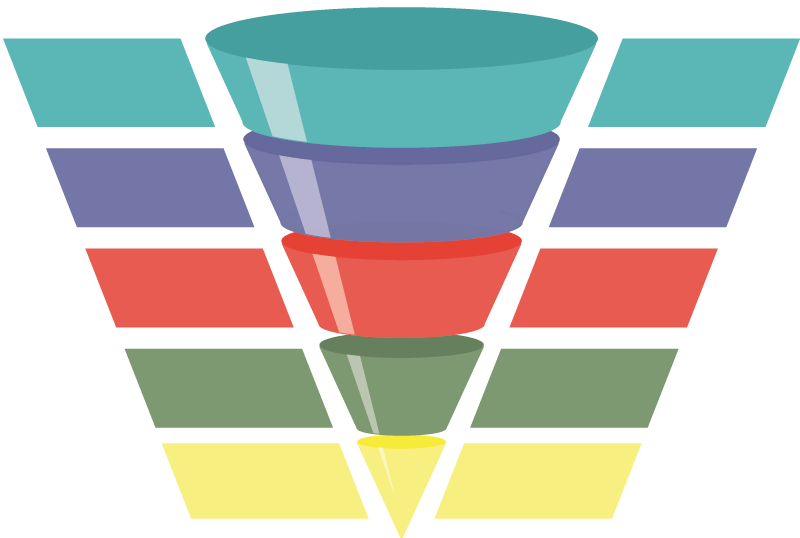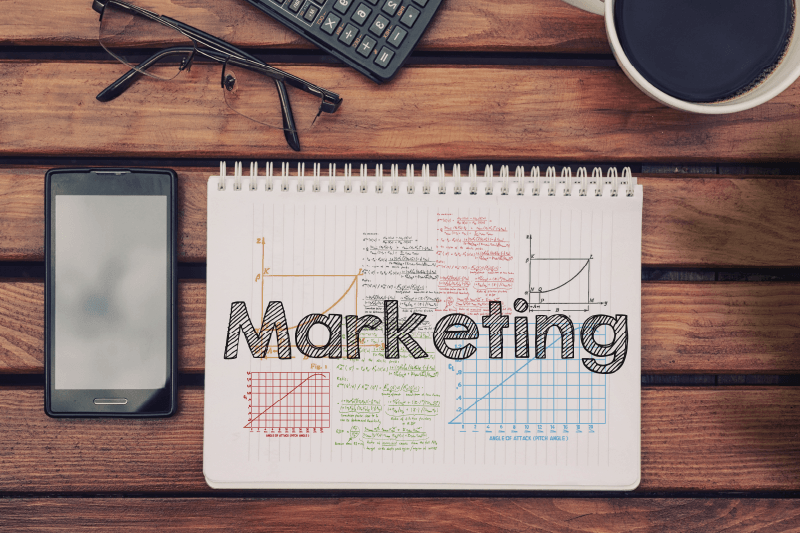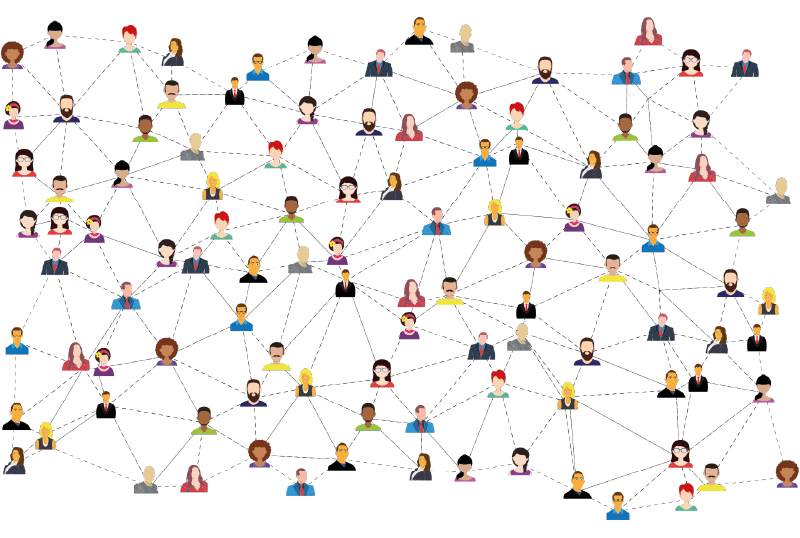How Digital Marketing Transformed The Sales Funnel
Tech has changed a lot about how we do business, so is the old, literally Victorian, sales funnel still fit for purpose?

If you’re in business – and especially in sales – you’re probably well aware of the traditional sales and marketing funnel. The wide end of the funnel welcomes in new parties who reduce in number until only paying customers come out of the narrow end. It’s a useful way to visualise the sales process.
But a lot has changed to sales and marketing since the sales and marketing funnel was first conceived; it was back in 1898, after all! It’s not very often that we hold on to ideas from Victorian times in business – so is the trusty, old sales funnel of yore still relevant in the world of Digital Marketing and beyond?
What is a Marketing Funnel?
The marketing funnel, also called the sales funnel or purchase funnel, is a visualisation of a buyer’s journey; covering the differing levels of engagement from a mildly interested prospect, through to becoming a paying customer. These differing levels of engagement are usually visualised as horizontal layers within a funnel shape.

These differing levels of engagement generally have an “AIDA”-like flow, though companies can change and add as many layers as they like to envisage a marketing funnel that makes most sense to them. The AIDA funnel is layered as follows (starting at the top):
Attention: The customer has noticed the company and is aware of them as a potential provider. The company is on the customer’s radar.
Interest: The customer’s interest has been piqued by the company and they’re now toying with the idea of purchasing from the company.
Desire: The customer has received or noticed an offer from the company that has really drawn their interest and they are somewhat interested in making a purchase.
Action: The customer has pretty much made the decision to buy, and just needs the right offer or the right approach to turn them into a paying customer.
The History of the Sales Funnel
The AIDA-esque funnel we know today was initially developed in 1898 by American advertiser E. St. Elmo Lewis. Marketing in those days was dominated by real old-school tactics as you can imagine: flyers, billboards, posters, roving salespeople, print ads, networking, and good old fashioned word of mouth.

As the 20th Century rumbled on, we eventually incorporated things like broadcast advertising, telesales, and eventually the first green shoots of digital advertising.
Throughout these changes, the traditional funnel held strong. The sales journey was still very linear – you were either in the sales funnel and roughly within a predefined stage, or you weren’t in it at all. The company doing the advertising largely controlled the narrative – marketers would craft the right message and salespeople would close the deal.
But technology has forever changed how we interact with businesses.
Web 2.0: A New Marketing Frontier
Fast-forward to the 2000s and the arrival of “Web 2.0”, the second era of the internet. It represents the explosion of social media, the mobile internet, and web apps that can be used directly from your browser. Truly, it has shaped the way we engage online. I mean, can you imagine an internet without any of the following?
Content Marketing (Including Blogs, Videos, Podcasts, et al.)
Social Media
Pay-per-click Advertising
Web Apps like Google Docs and cloud CRMs
SEO
Cookies and Data Analytics

How The Digital Marketing Era Changed Sales & Marketing
Experimentation & Diversification is No Longer a Risk
In the pre-digital era of advertising, huge marketing budgets were needed to conjure mass appeal. Trying out new messaging, experimenting with new marketing channels, reaching new audiences, and generally taking promotional risks could be a real gamble.
If a company wanted to set up shop abroad or reach a new demographic on home turf, there could be months of preparation, focus groups, and outreach just to decide whether it’s a good move or not. Even with this work carried out, campaigns could still be quite expensive and fail to hit the mark.
Thankfully with today’s global connectivity, thorough usage analytics, and inexpensive digital marketing channels, trying out new promotional ideas is simple and inexpensive. Marketers can A/B test new, creative campaign ideas on smaller audiences and gauge their effectiveness before releasing them to the world at large.

Better Targeting Creates Person-Centred Marketing
Old school mass-marketing could be very impersonal and campaigns were often crafted around very broad, demographic-based buyer personas, especially in the B2C world.
However nowadays, organisations can gather very precise, granular statistics about the kinds of people who interact with their brand. There’s no guess-work, no assumptions – they know who browses their site and buys from them because it’s laid out in black and white (or perhaps blue and orange if you’re using Google Analytics!).
This information gives the advertiser the power to identify new, potentially lucrative, under-served segments within their audience and show them different, highly targeted ads based on their individual needs and priorities. This more tailored approach of digital marketing allows you to build highly personalised offers which resonate with these sub-groups and boost conversions.
Discover How SpotlerCRM Can Help
Marketing & Sales Now Combined… And Stronger than Ever!
Finally the promotional dream team is being seen as two parts of the same whole, rather than two separate (and often warring) factions.
Traditionally, the marketing department kept the stream of qualified leads coming in and sales closed the deal. There was often a quite defined cut-off point in the marketing funnel where warm leads were handed to the sales department and ne’er the twain met.
How things change! Digital marketing practices like blogs, videos, chat functions, and email marketing have blurred the lines between the two departments; forcing the two once acrimonious factions into a powerful, blended “smarketing” team.
Nowadays, both sets of disciplines generally work together to achieve digital marketing KPIs. And let’s be honest – a collaborative approach is always going to work better than two fragmented factions at loggerheads. Digital marketing have forced these teams to get together and play nice!

Sales Funnels: Out With the Old, In With the New?
It can’t be understated that social media, mobile connectivity, and the sheer ubiquity of the internet has connected us all like never before. We’re constantly surrounded by new connections and attention-grabbing content, with review sites (and the occasional social media rant) often being an essential part of a buyer’s journey.
However, herein lies one huge problem with shoehorning our new ways into the old sales funnel. The modern internet is a constant battle for our attention – which, as you’ll remember, is an essential, assumedly plentiful, first part of the AIDA model. As modern life gets busier and time feels in shorter supply, the average person’s attention gets spread ever more thinly.
In the midst of this digital cacophony, companies have more of a job on their hands to keep buyers’ attention once they’ve got it. It’s also harder for companies to monopolise and control the narrative around their brands, what with social posts, rating sites, and review content out there – all effectively acting as word of mouth at scale (for better or worse!). Brand loyalty and advocacy is now an important part of the after-sales process – something that Lewis’s funnel sidesteps entirely.
How The Marketing Funnel Has Changed Beyond Recognition
These new developments have led sales and marketing boffins to completely transform the idea of Lewis’s sales and marketing funnel. Let’s explore a handful of modern alternatives to the possibly obsolete funnel of old.
A Longer, Stretchier Funnel
Sales processes are getting much longer – especially in B2B environments. When making a buying decision, buyers now have more information at their fingertips than ever before, especially during the traditional “attention” and “interest” phases, so it stands to reason that they’ll need more time to digest it all.
Additionally, there’s the real battle to earn an audience’s sustained attention. In order to keep an audience engaged and brand-aware, an advertiser needs to follow prospects around the internet with well-thought-out omni-channel campaigns.
This all means that the buyer has a greater opportunity to take a more meandering path towards a sale than ever before. They have space to twist and turn in non-linear ways as they find out more and go down research rabbit holes.
In direct contrast, buyer journeys can be quicker than ever in rapidly moving markets like fast-moving consumer goods (FMCG). This is largely due to the rise of in-app purchases and the ability to list and buy products directly through social media. Therefore, funnels need to stretch or shrink to accommodate.
The Fat-Middle Funnel
This version of the funnel doesn’t seek to reinvent the wheel – or indeed, the sales funnel. It merely serves to redesign the funnel to illustrate where some digital marketers should be focusing: on the crucial “interest” and “desire” stages.
As we’ve already discussed, attention online can be fleeting. But once you’ve piqued someone’s interest, that’s where the real challenge comes – turning that interest into a desire to purchase and turning that desire into action. The Fat Middle funnel, quite rightly, puts emphasis on these crucial middle stages.
The Looping Online Journey
Other approaches posit that we’re looking at the trusty kitchen utensil from the wrong direction. Look at a funnel from the top down and what have you got? A circle!
One way of considering the modern sales journey is as a looping process. As with the traditional funnel, it starts with awareness. As the buyers filter down towards the “consideration” stage, more cautious buyers can detour to a “research and discovery” loop that eventually brings them back to the main path.
When they eventually buy, they enter a post-purchase phase with an optional “loyalty loop” to visualise loyal customers bypassing the previous stages and directly circling back to make another purchase or recommending the brand to their contacts.
This alternative approach builds on the traditional funnel by adding an optional step for customers to go away and do their own research, as well as including the possibility of post-purchase loyalty.
In my view, that loyalty loop is an important addition. The ideal goal nowadays is no longer simply to win the sale, but to earn enough good favour with the customer that you achieve repeat business as a result.
The Sales Flywheel
This is an interesting one, as it serves to illustrate both buying stages and the sales momentum that comes from producing more happy customers and generating positive word of mouth.

The sales flywheel focuses on three main stages: Attract, Engage, and Delight, which seek to turn strangers into prospects, prospects into customers, and customers into advocates for the brand. These “promoters” drive more strangers into the flywheel and in turn keep the whole wheel spinning freely.
This model incorporates post-sale loyalty as an inseparable ingredient to sales success rather than a single sale being the only aim.
The Hourglass Funnel – One Funnel Becomes Two?!
This is another way of considering both the pre- and post-sale processes. The buyer flows through the top half of the funnel in a similar fashion to Lewis’s funnel, but when they make a purchase, they enter an inverted funnel – creating an hourglass shape.
The stages in this bottom section include a honeymoon phase when the customer starts using the product; a retention phase where customer satisfaction is assured; an optional upsell/cross-sell phase where the customer seeks more solutions from the company as their brand loyalty grows; and an advocacy stage where they become willing repeat customers and brand advocates.
In Conclusion
Lewis’s funnel has undoubtedly served us well and it has certainly stood the test of time. However, the way we buy nowadays is very different. Our attention is now focused so differently and stretched so thinly that his assumption that attention is out there, ready for the picking, is no longer strictly accurate.
The AIDA funnel also fails to consider what happens after a sale. I’m sure maintaining buyer loyalty was as important in the olden days as it is today, so its omission seems a bit of an oversight through today’s lens. However in the days of fewer options and limited access to information, perhaps buyer loyalty was more of a given once a prospect became a happy customer.
Though there are numerous ways of reimagining the marketing funnel, it does make us wonder whether any of them are going to have quite the same lasting impact as Lewis’s traditional funnel. Or perhaps we’ll have new and interesting ways of looking at the sales and digital marketing journey! We can only wait and see…
Are you exploring new ways to handle customer and prospect data, produce sales reports, and keep in touch with your contacts? Give SpotlerCRM a try!
Our intuitive yet powerful CRM is designed especially for small to medium enterprises that strive to build long-lasting client relationships through outreach, collaboration, and data. Make the most of our no-obligation 14-day free trial – register today!
Really Simple Systems is now Spotler CRM
The same great technology, a CRM platform that is focused on the needs of B2B marketers, provided by the same great team, at a great price!